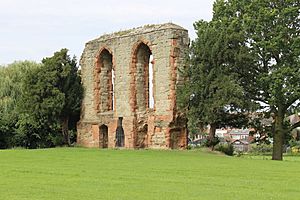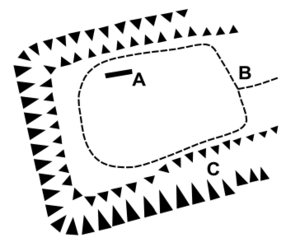Caludon Castle facts for kids
Quick facts for kids Caludon Castle |
|
|---|---|
| Coventry, England | |

The lone sandstone wall, all that remains of Caludon Castle
|
|
| Coordinates | 52°25′05″N 1°27′07″W / 52.418154°N 1.451822°W |
| Site information | |
| Owner | Coventry City Council |
| Controlled by | Coventry City Council |
| Open to the public |
Yes |
| Condition | Ruined |
| Site history | |
| Materials | Grey sandstone |
| Battles/wars | English Civil War |
Caludon Castle is a very old and important ruin in Coventry, England. It's known as a Scheduled Ancient Monument, which means it's a protected historical site. It's also a Grade I listed building, showing its special historical value.
Today, only a large piece of sandstone wall remains of the castle. The land around it is now a public park, managed by Coventry City Council. However, in the past, much of the castle's land was sold and turned into houses.
People have lived on this spot since at least the 11th century. The first building here was a large house, even before the Norman conquest of England in 1066. Over time, it became a grand manor (a large estate with a lord's house). It was rebuilt several times, becoming a castle and then a mansion. The castle was mostly destroyed in 1662 and has been a ruin ever since.
Contents
What is Caludon Castle?
Caludon Castle is located in Wyken, a part of Coventry. The original estate was much bigger than the park you see today. It stretched from the River Sowe in the south-east to higher ground in the north-west.
The Castle's Design
The first castle was shaped like an oval. It had strong defensive walls with towers and was surrounded by a moat (a deep, wide ditch, usually filled with water, for protection). You would enter through a gatehouse and a bridge on the east side.
Most of the living areas were on the north and west sides. The kitchens and offices were on the south and east. Outside the moat, there were farm buildings, gardens, and a bowling green.
When the castle was changed into a mansion around 1580, many other buildings were still standing. These included a porter's lodge (where a doorkeeper lived) and a brewing house.
What Remains Today
In 2008, a special survey found the foundations of a large rectangular building. This was likely a great hall, about 33 by 13 metres (108 by 43 feet). The survey also found signs of other living buildings and a path around the inside of the site. This shows that the castle was built in different stages over time.
About 190 metres (620 feet) south of the castle, there's another moat. This moat was built in the Middle Ages, probably around 1305. It's also a Scheduled Ancient Monument. This second moat might have surrounded farm buildings connected to the castle.
A Look at Caludon Castle's History
The land where Caludon Castle stands has a long and interesting history.
Early Days and Noble Families
The first house on this site existed before the Norman Conquest. After the conquest, it belonged to the Earls of Chester. Around 1232, it was given to Stephen de Segrave, who was a very important judge in England called the Chief Justiciar.
His family, the Segraves, then owned the property. It was first called a "manor" in 1239. At that time, it was the only permanent home for a nobleman in Coventry. The estate grew bigger in 1279 when Nicholas de Segrave, 1st Baron Segrave bought more land and a mill.
Becoming a Castle
The house probably became a castle in 1305. This was when John de Segrave, 2nd Baron Segrave, was given permission by King Edward I of England to "crenellate" the property. This meant he could add battlements (the rectangular gaps in the wall) to the top of the walls. While these were once for archers, by this time, they were mostly a sign of wealth and importance. He also got permission to build a moat and a wall. A chapel and other buildings were added too.
More rebuilding happened in 1354, with another permission to crenellate.
Famous Owners and Royal Drama
In the late 1300s, the castle was inherited by Thomas de Mowbray, 1st Duke of Norfolk. In 1398, he accused Henry of Bolingbroke (who later became King Henry IV) of treason against King Richard II.
The two noblemen were supposed to fight a duel near the castle. But King Richard II stopped the duel and banished both of them from England. After Henry became king, he took away Mowbray's title. Mowbray died soon after while in exile.
His son, John de Mowbray, 2nd Duke of Norfolk, inherited the castle and got his dukedom back. The Mowbray family owned the castle until 1481.
From Mansion to Ruin
After 1481, the castle was owned by William de Berkeley, 1st Marquess of Berkeley. It was left empty and damaged for a long time after Mowbray's banishment.
Around 1580, Henry Berkeley, 7th Baron Berkeley rebuilt it as a grand mansion. A large banqueting hall was added later. The mansion was badly damaged in 1662. This happened when King Charles II punished Coventry because the city had supported the Parliament during the English Civil War.
The castle remained in ruins. In 1800, the old stones were used to build a large farmhouse on the site. In 1815, the estate was divided and sold. Later, after the First World War, Coventry Corporation bought much of the land and built houses there.
Caludon Castle Today
Today, Caludon Castle is a ruin. The only part of a building still standing above ground is a large grey sandstone wall. This wall has been the only remaining part since at least the early 1700s.
The wall has two large windows with decorative stone patterns called tracery. These patterns are made of red sandstone, which stands out against the grey wall. Red sandstone also appears at the ends of the wall, suggesting it was once much longer and had more windows. Below the large windows are two smaller ones, which might have been part of an undercroft (a cellar or storage room). A flue (a channel for smoke) runs between the windows. This wall fragment is believed to be from the 14th century, probably from the rebuilding in 1354.
The castle is now part of a small public park called Caludon Castle Park. Coventry City Council owns and manages it. The moat around the castle is now dry, and some parts are filled in. However, you can still see parts of it and other earthworks (changes made to the land by people long ago).
Both the remaining wall and the moated site to the south are protected as Scheduled Ancient Monuments. Since 1955, the wall has also been a Grade I listed building, showing its very high historical importance.
|



